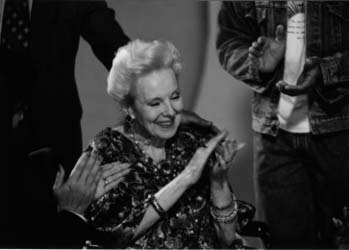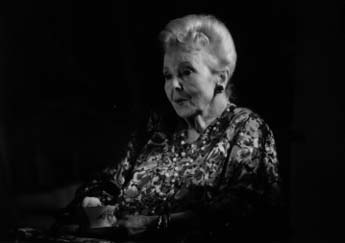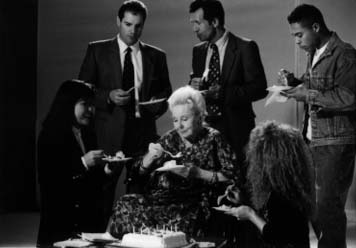

80 minutes; 16mm; color; sound.
Copyright © 1993 Wheeler Winston Dixon. All Rights Reserved.

Starring Anna Lee
With Dao Hale
Daryl Hemmerich
Jill H. Savitz-Pryor
Sam Alejan
Aric Rogokos
"What Can I Do?," November 18, 1993, Anthology Cinema Archives, New York, New York. (Invited)
"What Can I Do?," January 6, 1994, invitational press screening, Tribeca Screening Room, New York, NY.
"What Can I Do?," January 18, 1994, (Two Screenings; 3 and 6PM), The Museum of Modern Art, New York, New York. (Invited)
"What Can I Do?," January 21, 1994, Nelson - Atkins Museum of Art, Kansas City, MO. (Invited)
"What Can I Do?," March 3-6, 1994, Society for Cinema Studies National Convention, Syracuse, NY. (Refereed)
"What Can I Do?," March 23, 1994, Museum of the Moving Image, National Film Theatre, London. (Invited)
"What Can I Do?," April 22, 1994, Mary Riepma Ross Film Theatre, Lincoln, Nebraska. (Invited)
"What Can I Do?," April 30, 1994, The 1994 International Conference on Narrative Literature, The Society for the Study of Narrative Literature, Simon Fraser University, Burnaby, British Columbia, Canada. (Invited)
"Thanks for sending the video tape of WHAT CAN I DO? It's very effective. The star gives a very fine performance and the counterpoint 'creeper' of her lines works well. There's a hell of a lot of smoking! It doesn't cloud the issue, though."
-- Michael Snow, 2/9/97.
"Like Molly Bloom's long monologue which closes Joyce's Ulysses and in its "excess"ive realism puts an end to conventional realist narrative, What Can I Do? critiques and gestures towards the emergence of a new Post-story film. What Can I Do? is a resistance film on counter-memory and a protest against a world that no longer has a place for collectivity. "
--Mas'ud Zavarzadeh, Department of English, Syracuse University
"A searing study of loneliness. An elderly hostess narrates her life to five guests in the hope of attaining that elusive desire of most human beings: true communication."
--Brian McIlroy, Department of Theatre and Film, University of British Columbia
"Mesmeric . . .This is minimalist cinema at its most holding."
--Brian McFarlane, Monash University, Melbourne, Australia
"Creates the kind of intense engagement that one might expect if My Dinner With André were filmed by Chantal Akerman."
--Lloyd Michaels, Editor, Film Criticism
"Mesmerizing . . . I thought Anna Lee's performance superb. What Can I Do? invites comparison with Samuel Beckett's Happy Days . . . --Edward T. Jones, Chair, Film Studies Program, York College
"Four Stars . . . Wheeler Dixon's What Can I Do? is, without question, a serious work of cinema . . . [Anna Lee gives a] remarkable performance . . . Dixon's challenging work has already sparked plenty of academic commentary . . . compelling."
-L. Kent Wolgamott, Journal/Star Newspapers
"Like Molly Bloom's long monologue which closes Joyce's Ulysses and in its "excess"ive realism puts an end to conventional realist narrative, What Can I Do? critiques and gestures towards the emergence of a new post-story film. Dixon's contribution to the postfilm, however, exceeds mere formal questionings. It is, above all, a postmodern political meditation on the cultural discontinuities of late capitalism and the place of woman in it. It is a rigorous Foucauldian genealogy of femininity, the female desire and the question of "other"ness in the commodity culture. Although formally it is radically different from such postmodern neo-pedagogical films as Boyz N The Hood, What Can I Do? is a resistance film on counter-memory and a protest against a world that no longer has a place for collectivity, and regards itself to be post-historical." --Mas'ud Zavarzadeh, author of Seeing Films Politically (1991), Department of English, Syracuse University
"A searing study of loneliness. Wheeler Winston Dixon's new film seeks successfully for the appropriate formal devices to convey the terrible sense of isolation we all fear will be the fate of many of us. An elderly hostess narrates her life to five guests in the hope of attaining that elusive desire of most human beings: true communication. What emerges is a Beckettian cinematic world: spare, clear, hard and desperate. A stimulating post-modern work."
--Brian McIlroy, author of World Cinema 4: Ireland (1989), Department of Theatre and Film, University of British Columbia
"Mesmeric . . . you have allowed/encouraged/made it possible for Anna Lee to give a superb performance. By this I mean that the screenplay never hits a false note so that she and it seem somehow symbiotically bonded; and you know exactly how long to leave the camera on her. I wonder if there has ever been a longer speaking part in a film. In this riveting study of delusion, truth-telling and suppressing, a whole life is remorselessly laid bare. This is minimalist cinema at its most holding: its power is in its screenplay, in the precision of its editing, and in the commanding central performance of Anna Lee, going beyond anything she has achieved in a long and honorable career. It is a film for people who are prepared to work for their satisfactions, but they will find the effort rewarded."
--Brian McFarlane, author of New Australian Cinema , Department of English, Monash University, Melbourne, Australia
"What Can I Do? operates in a deceptively simple format but mediates the narrative according to a complex system of cinematic and aural operations designed to subtly unsuture any viewer attempt at totalising coherence. With visual style and off-screen sounds designed to question monologic omniscience, the work challenges the viewer, subtly testing spectator control and narratological format."
--Tony Williams, author of Vietnam War Films, Dept. of Cinema and Photography, Southern Illinois University, Carbondale, Illinois
"Creates the kind of intense engagement that one might expect if My Dinner With André were filmed by Chantal Akerman."
--Lloyd Michaels, Editor, Film Criticism
"Mesmerizing . . . I thought Anna Lee's performance superb. What Can I Do? invites comparison with Samuel Beckett's Happy Days . . . which is doubtless a tribute to your astringent script and film technique."
--Edward T. Jones, Chair, Film Studies Program, York College
"What Can I Do? is a most interesting and unusual film. Its narrative construction contradicts traditional film discourse but wholly captures the involves the viewer for its 80 minutes. The film is basically a soliloquy on the life of an elderly and affluent woman (Anna Lee) who is talking to five dinner guests in her New York apartment. But actually she speaks to and directly involves the viewer by looking at and talking to the camera throughout the film. Her continuous soliloquy is occasionally presented against shots of the dinner guests from unusual perspectives and with blocks of written text of her previous dialogue presented in long scrolling sections superimposed upon her current dialogue.
This produces a most interesting effect as the viewer tries to process two sources of dialogue presented in two different modalities simultaneously. The script is sad, literate, interesting and insightful as it carries the viewer along Miss Lee's rather sad journey through her character's life. Miss Lee is the prefect hostess, emanating a distinctive and regal beauty and courage, as well as befuddlement at her fate, which makes her a wholly human and sympathetic character. I highly recommend this engrossing film."
--Laurence Miller, Chair, Department of Psychology, Western Washington University
"My film What Can I Do? (1993) constitutes a further exploration of the reciprocal discourse between spectator, image, and performer. In the film, an old woman (Anna Lee) gathers a group of paid dinner guests in her New York apartment for an evening of dinner and drinks. The film's narrative begins at the conclusion of dinner, as the woman opens a bottle of Scotch and attempts, in the manner of Scheherezade, to beguile her "guests" into staying the night.
The film is meant to be a difficult work, one that challenges the audience to interpret the material it presents in a non-traditional manner, and a film that intentionally violates nearly every "rule" of traditional narrative construction, to create a fictive construct that willfully seeks to deconstruct itself, even as it casts a spell over the audience. In this respect, the film is entirely post-modern, eschewing the safety of the fictive constructs usually created by Hollywood (and other establishment) film discourse.
Though the film was shot on a soundstage in Los Angeles, and compresses an entire evening into eighty minutes of performance duration, What Can I Do? directly addresses the politics of verisimilitude within fictive constructs through the agency of the woman's direct address to the spectator, which forms the central informing structure of the work. As the film progresses, we see that the woman is not only looking at us; she is also looking at her five guests, who directly return her gaze in a series of precise eye-matches. Intercut with the woman's monologue are extreme close-ups of the listeners smoking, pouring coffee with cream, drinking wine, and blocks of written text from the woman's diatribe, presenting in long scrolling sections against the flow of the narrative.
The construction of the film thus operates on a number of intentionally conflicting levels. One one level, it is an oral history of fictitious events, events that are, incidentally, called into question by the narrator herself, who reminds her listeners (and the members of the audience) that her entire narrative may well be "a lie;" on another plane, the film is a staged fictive meditation on the power of the look in all its manifestations: the look of the viewer, the diegetic eye-matches between the protagonists of the film, and the "look back" of the woman, her guests, and the reflected gaze of the camera itself.
Viewed from another perspective, the film emerges as a self-reflexive consideration of the fictive act, in which staging, lighting, props and sets are all acknowledged as the emblems of the iconic support system employed by more conventional, "non-materialistic" film practice. Foregrounding the power of the gaze, the film contains only 89 cuts in its entire 80 minute running time, allowing the identity of the viewer to merge with that of the guests, and reinforcing the reciprocal interlock of eye-matches between the teller of the tale, and the auditor of the cinematic apparatus attendant to the production/representation/presentation of the film. Finally, the relentless oral sweep of the protagonist's voice becomes a voice of the living film/body itself, holding the double audience of the film (the listeners, the audience) prisoners within the scopic thrall of the work."
--Wheeler Winston Dixon
PRODUCED WITH SUPPORT FROM THE SOUTHWEST ALTERNATE MEDIA PROJECT AND THE LAYMAN FUND OF THE UNIVERSITY OF NEBRASKA, LINCOLN.





